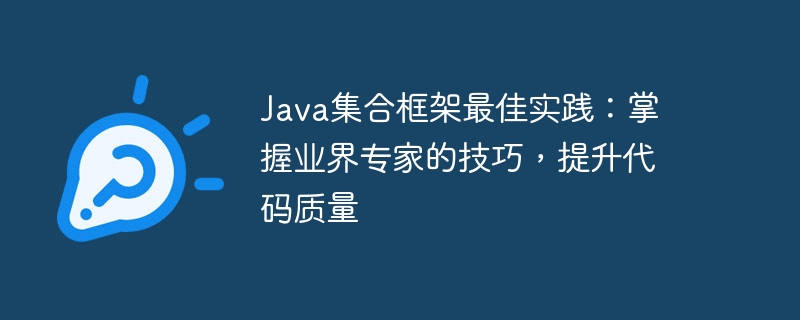Home >Java >javaTutorial >Java Collection Framework Best Practices: Master the skills of industry experts to improve code quality
Java Collection Framework Best Practices: Master the skills of industry experts to improve code quality
- PHPzforward
- 2024-02-23 10:25:481177browse

This article written by PHP editor Xiaoxin aims to share the best practices of the Java collection framework, help readers master the skills of industry experts, and improve code quality. The Java collection framework is an indispensable part of Java programming. Correct use will greatly improve the efficiency and maintainability of the code. By studying this article, readers will understand how to use the Java collection framework in actual projects, avoid common pitfalls and mistakes, and write better and more efficient Java code.
-
Choose the appropriate collection type: The Java collection framework provides various types of collections, such as List, Set and Map. When choosing a collection type, you should consider the characteristics and performance requirements of the data structure. For example, if you need to store unique elements, you can use a HashSet; if you need to store ordered elements, you can use an ArrayList.
-
Use generics: The Java collection framework supports generics, which can help you check the type of elements stored in the collection at compile time to avoid errors caused by type mismatch. For example, you can use List
to create a list that can only store string elements. -
Avoid using primitive types: In the Java collections framework, primitive types (such as int, float, and double) are wrapped into corresponding wrapper classes (such as Integer, Float, and Double). When using the collection framework, try to use wrapper classes instead of primitive types. Doing so improves the readability and maintainability of your code and avoids unexpected type conversion errors.
-
Use iterators: When traversing a collection, you should use an iterator (Iterator) instead of using a for loop directly. Iterators provide a more flexible and safe traversal method, which can avoid ConcurrentModificationException errors when the collection is modified.
-
Avoid using null values: In the collection framework, the null value is a special value that indicates that the element does not exist. When using the collections framework, you should try to avoid using null values because null values make the code difficult to understand and maintain. If you do need to use null values, you should explicitly check for null values in your code to avoid NullPointerException errors.
-
Use concurrent collections: In a multi-threaded environment, concurrent collections (ConcurrentCollection) should be used when using the collection framework. Concurrent collections can support simultaneous access by multiple threads to avoid errors caused by concurrent access. The Java collection framework provides a variety of concurrent collections, such as ConcurrentHashMap and CopyOnWriteArrayList.
-
Use collection view: Collection View (Collection View) is an important feature of the collection framework. Collection views allow you to view and access elements in a collection in different ways. For example, you can use a sublist view (SubList) to view a subset of the elements in a collection, or a sorted view (SortedSet) to view the elements in a collection in ascending or descending order.
-
Use lambda expressions and streams (Stream): Java 8 introduced lambda expressions and streams (Stream), which makes the operation of the collection framework easier and more efficient. You can use lambda expressions and streams to filter, map, sort, and more elements in a collection.
-
Using Java 8's new collection API: Java 8 introduces some new api in the collection framework, such as Stream API, Collectors API and Optional API. These new APIs help you process and manipulate elements in collections more easily.
-
Use a third-party collection framework: The Java collection framework is very powerful, but it also has its own limitations. If you need a more powerful collections framework, consider using a third-party collections framework such as Guava and Apache Commons Collections. These third-party collection frameworks provide more data structures and algorithms to meet more complex application requirements.
The above is the detailed content of Java Collection Framework Best Practices: Master the skills of industry experts to improve code quality. For more information, please follow other related articles on the PHP Chinese website!
Related articles
See more- What is the computer performance metric measured in MIPS?
- Tips and best practices for using the render function to implement component rendering in Vue
- Best practices for using gRPC to implement concurrent data transmission in Golang
- How to handle concurrent access to MySQL database?
- PHP 8.3 new features at a glance: enhanced code quality and maintainability

